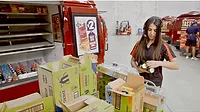Voice technology helps beverage distributors serve diverse customers
Pick accuracies realize near-perfect levels, experts note

For the upcoming generation, the names Siri, Alexa and Cortana might be as commonplace as mom and dad. In fact, information technology research and advisory company Gartner predicts that by 2020, 30 percent of web browsing sessions will be done without a screen. Although vocal interactions might be extending web experience to cooking, exercising and other consumer activities, warehouse operations also are embracing advancements in voice technology.
The evolution of today’s beverage market has contributed to the growing interest in voice technology. Among the trends having a significant impact is SKU proliferation.
“SKU proliferation continues to make an impact on warehouse operations, with greater product variety challenging them to manage and move a larger, more diverse inventory,” says Scott Powell, voice product leader for Honeywell Safety and Productivity Solutions, Fort Mill, S.C.
Powell notes that voice technology is helping beverage warehouses address the challenges that arise as a result of the increasing number of SKUs.
“Voice can help operations make the most of DC/warehouse space, avoid housing excess inventory and ultimately distribute goods more quickly,” he says. “Accuracy is critical to maximizing throughput volume with a larger inventory made up of [a] greater variety of SKUs. Voice technology virtually eliminates the risk of human error in picking processes, and our findings indicate that it enables companies to achieve a 99.995 percent accuracy rate. This allows them to deliver the perfect order and maintain high customer satisfaction.”
In addition to balancing a growing portfolio, beverage distributors are tasked with recognizing the unique needs of their partners in the retail arena. Powell highlights that voice technology is allowing these wholesalers to do so with increased flexibility.
“In addition to variety in the inventory they manage, beverage distributors also serve a diverse customer base with varied requirements and order specifications,” he says. “For example, a big box store may order inventory by the pallet load, but smaller outlets like convenience stores may order smaller quantities. Voice provides the necessary flexibility to provide high performance no matter the order size — whether picking individual each orders, cases and pallet quantities.”
Efficient and cost-effective
When operations managers consider whether to invest in new programs and equipment, the cost-benefit analysis often comes into play. However, experts note that the return-on-investment (ROI) for voice technology makes it financially friendly.
“Our customers typically report a full payback on their voice investment in nine to 12 months, while some achieve ROI as quickly as six months,” Powell says. “This comes via benefits like improved accuracy, speed and safety, along with reduced training time, turnover and headcount.”
Powell sites Clark Beverage Group as an example of these efficiencies. “Our system greatly reduces training time compared to alternative picking approaches such as paper-based systems,” he says. “For example, in this recent case study with Clark Beverage Group, implementing a Honeywell Vocollect voice solution drastically reduced the company’s training time. Workers are up and running with voice in less than two days, when training used to take two weeks.”
However, reduced training time is just one of the many benefits that Powell says Honeywell’s partners have enjoyed. “While many of our customers are focused on attaining productivity gains by implementing voice, we see that one of the greatest returns is the increase in accuracy,” he explains. “Quality control is critical for achieving high levels of customer satisfaction, and voice virtually eliminates the risk of human-prone errors.”
To support beverage warehouses, Honeywell offers its Vocollect voice technology, which integrates with all major warehouse management systems (WMS) and entire resource planning (ERP) systems, including SAP, and supports various hand-held hardware platforms, Powell says. The company also developed Operational Acuity, a software suite that uses data collection, aggregation and predictive modeling techniques in conjunction with Vocollect, he notes.
“Operational Acuity shows operations managers exactly how their distribution centers are operating and where they can improve,” Powell says. “It adds cloud-based analysis on events that occur during work, such as shorts, prompt rates, workflow dialogs, prompt lengths, trouble spots, device restarts and battery warnings.”
As voice-first technology continues to be embraced by the masses, Powell predicts expansion in several areas.
“Voice technology enables work processes to become automated so that workers can perform tasks more productively and more accurately,” he says. “This can be applied to other complex, paper-based workflows, such as maintenance and inspection tasks.” BI
Looking for a reprint of this article?
From high-res PDFs to custom plaques, order your copy today!







